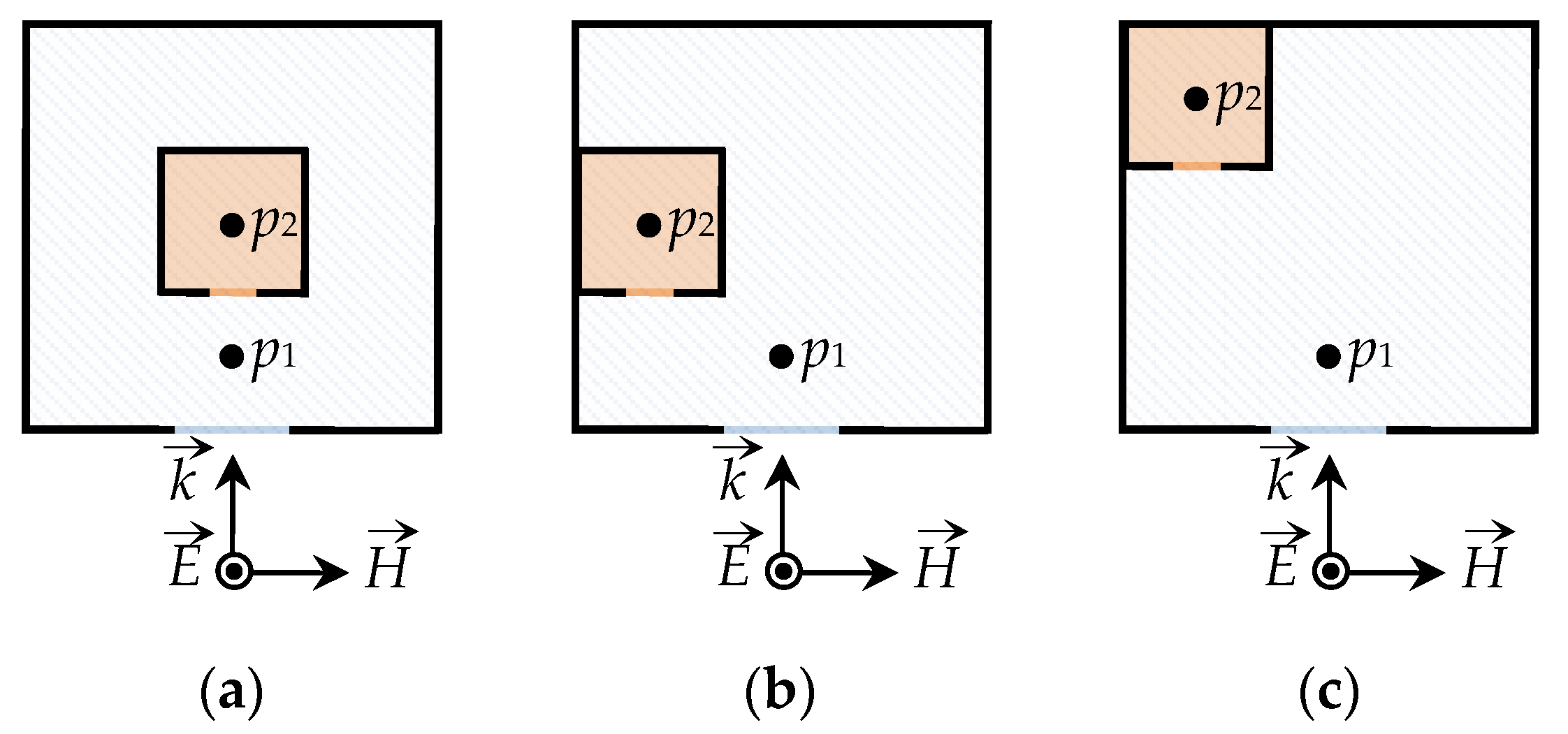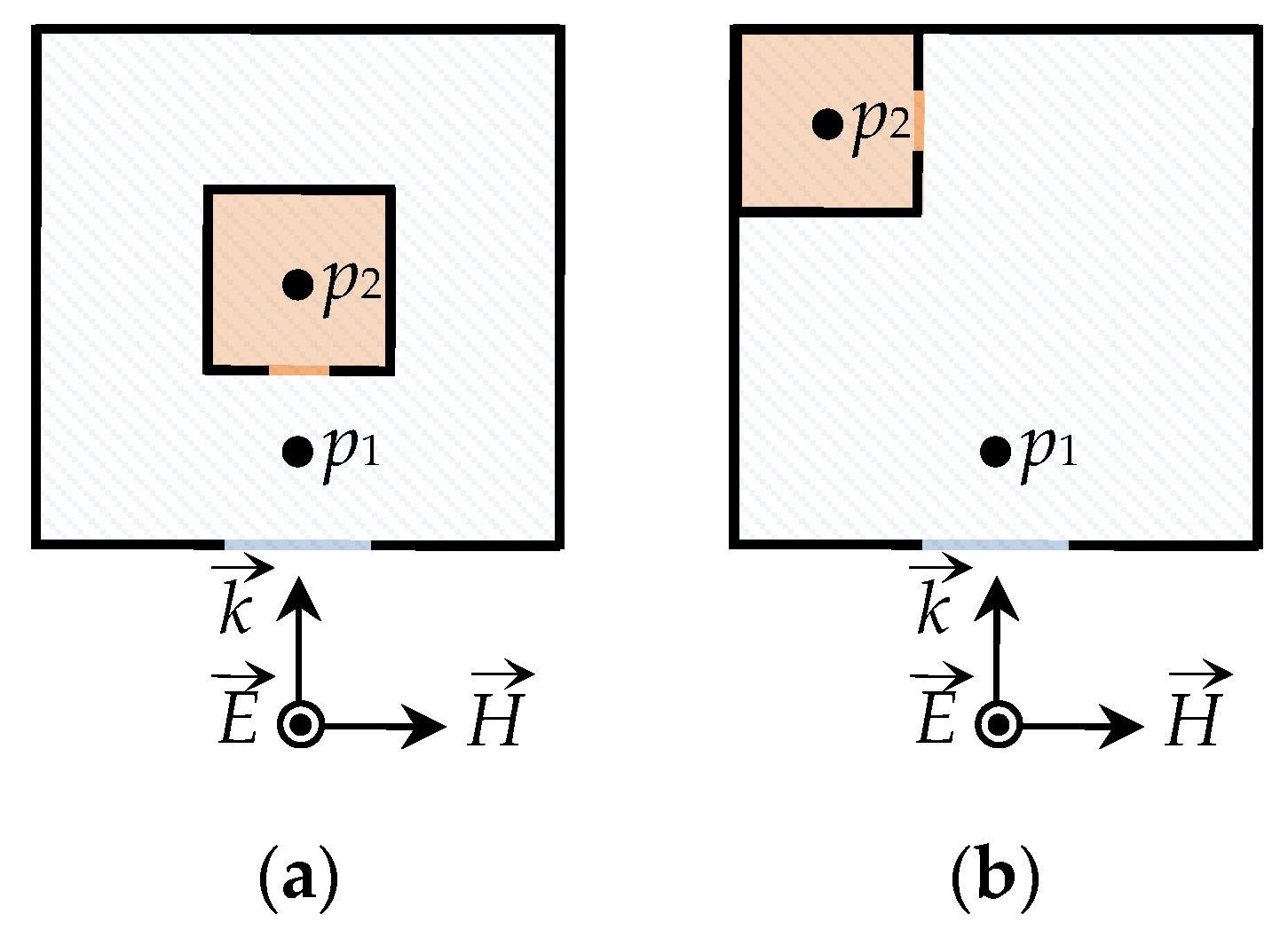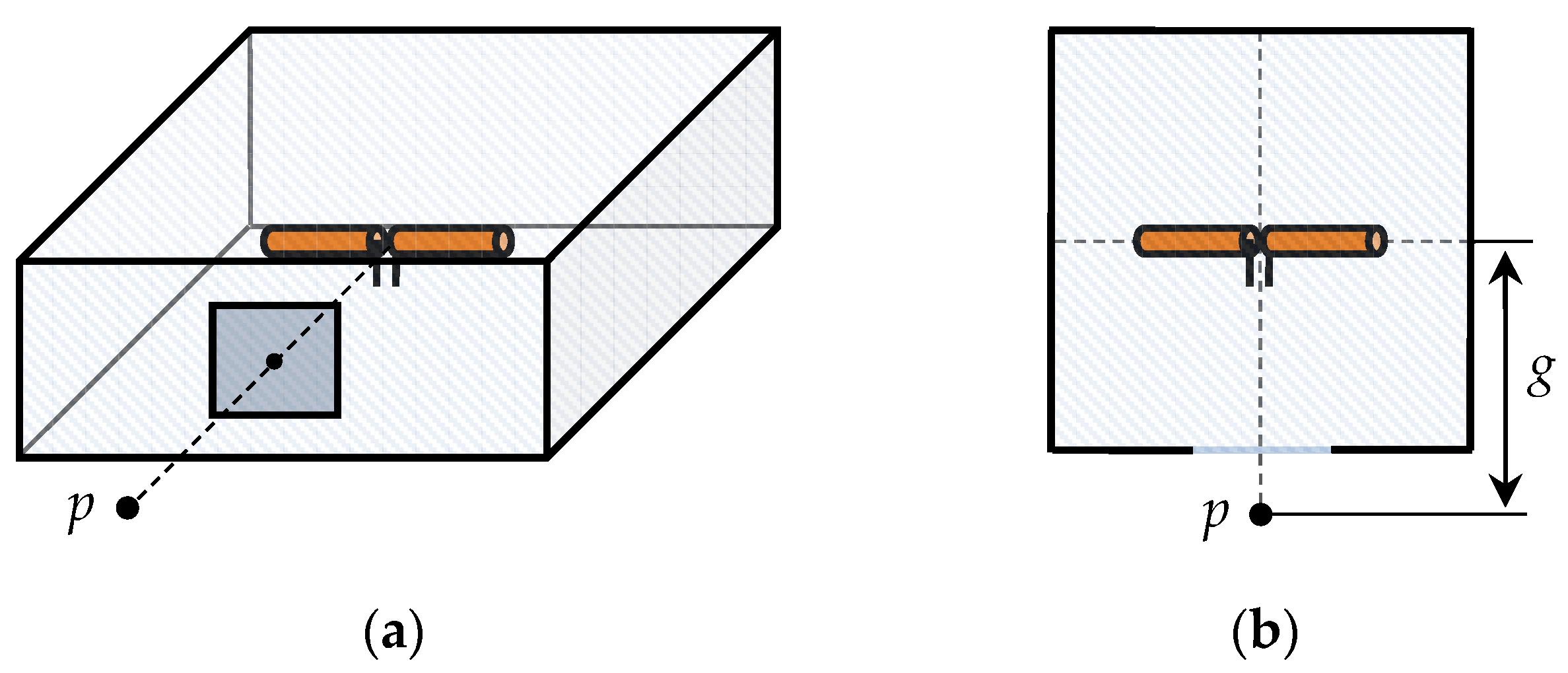On Symmetry and Asymmetry in Nested Electromagnetic Shields
Abstract
:1. Introduction
2. Materials and Methods
2.1. Simulation and Measurement Techniques
2.2. Electromagnetic Shields under Study
3. Shielding Effectiveness Analysis of Nested Shield System
3.1. Simulation of Shield System Elements
3.2. Changing the Mutual Arrangement of Apertures
3.3. Influence of the Mutual Arrangement of Enclosures
3.4. Insulated or Electrically Connected Enclosures
3.5. Analysis by Measurements
3.6. Comparison of the «Best» and «Worst» Cases
4. Radiated Emissions
4.1. Radiation Sources
4.2. Emissions in Single Enclosures
4.3. Emissions in the System of Nested Enclosures
5. Discussion
- Try to avoid a symmetrical mutual arrangement of nested shields. It is best to arrange the small enclosure on the side wall of the external enclosure or in its corner.
- Try to avoid counter arrangement of the apertures in a nested shield system. SE can be slightly increased by arranging the apertures mutually perpendicular.
- Try to electrically connect the nested enclosures to improve SE. This method should be used carefully, as poorly designed electrical connections can produce reactive elements that unpredictably change the resonance frequencies of the shield system.
- Try to size the shields so that their resonances do not coincide with interference frequencies. This will allow you to avoid increasing the level of electronic equipment emissions. If you cannot select the necessary shield sizes, the resonance frequencies of the shields can be shifted by using conductive plates [25] or posts [28].
- Try to use a standard approach that involves reducing aperture sizes in order to reduce electromagnetic coupling in the nested shield system. At resonance frequencies, electromagnetic coupling between nested shields can be reduced by using radar-absorbing materials [20], lossy dielectrics [19], or band-stop frequency selective structures [29].
6. Conclusions
Author Contributions
Funding
Data Availability Statement
Conflicts of Interest
References
- Celozzi, S.; Chiu, C.-N. Editorial introduction to the special issue on advances and perspectives in EM shielding and absorbers. IEEE Trans. Electromagn. Compat. 2022, 64, 1550–1551. [Google Scholar] [CrossRef]
- Schulz, R.B.; Plantz, V.C.; Brush, D.R. Shielding theory and practice. IEEE Trans. Electromagn. Compat. 1988, 30, 187–201. [Google Scholar] [CrossRef]
- Casey, K.F. Electromagnetic shielding behavior of wire-mesh screens. IEEE Trans. Electromagn. Compat. 1988, 30, 298–306. [Google Scholar] [CrossRef]
- Otoshi, T.Y. A study of microwave leakage through perforated flat plates. IEEE Trans. Microw. Theory Techn. 1972, 20, 235–236. [Google Scholar] [CrossRef]
- Mendez, H.A. Shielding theory of enclosures with apertures. IEEE Trans. Electromagn. Compat. 1978, EMC-20, 296–305. [Google Scholar] [CrossRef]
- Vitek, C. Predicting the shielding effectiveness of rectangular apertures. In Proceedings of the National Symposium on Electromagnetic Compatibility, Denver, CO, USA, 23–25 May 1989; pp. 27–32. [Google Scholar]
- Hill, D.A.; Ma, M.T.; Ondrejka, A.R.; Riddle, B.F.; Crawford, M.L.; Johnk, R.T. Aperture excitation of electrically large, lossy cavities. IEEE Trans. Electromagn. Compat. 1994, 36, 169–178. [Google Scholar] [CrossRef]
- Robinson, M.P.; Benson, T.M.; Christopoulos, C.; Dawson, J.F.; Ganley, M.D.; Marvin, A.C.; Porter, S.J.; Thomas, D.W.P. Analytical formulation for the shielding effectiveness of enclosures with apertures. IEEE Trans. Electromagn. Compat. 1998, 40, 240–248. [Google Scholar] [CrossRef]
- Flintoft, I.D.; Whyman, N.L.; Dawson, J.F.; Konefal, T. A fast and accurate intermediate level modelling approach for electromagnetic compatibility analysis of enclosures. In Proceedings of the 4th International Conference on Computation in Electromagnetics, Bournemouth, UK, 8–11 April 2002; pp. 1–2. [Google Scholar]
- Solin, J.R. Formula for the field excited in a rectangular cavity with a small aperture. IEEE Trans. Electromagn. Compat. 2011, 53, 82–90. [Google Scholar] [CrossRef]
- Azizi, H.; Tahar Belkacem, F.; Moussaoui, D.; Moulai, H.; Bendaoud, A.; Bensetti, M. Electromagnetic interference from shielding effectiveness of a rectangular enclosure with apertures—Circuital approach, FDTD and FIT modelling. J. Electromagn. Waves Appl. 2014, 28, 494–514. [Google Scholar] [CrossRef]
- Wu, G.; Zhang, X.-G.; Song, Z.-Q.; Liu, B. Analysis on shielding performance of metallic rectangular cascaded enclosure with apertures. Prog. Electromagn. Res. Lett. 2011, 20, 185–195. [Google Scholar] [CrossRef] [Green Version]
- Vaezikakhki, S.; Mosavinejad, S.S.; Bahadorzadeh, M. Study the effect of different parameters and improving the shielding effectiveness of a metallic enclosure with extra wall. J. Electr. Comput. Eng. 2019, 3, 53–57. [Google Scholar] [CrossRef]
- Bahadorzadeh, M.; Lotfi, A. A novel and efficient technique for improving shielding effectiveness of a rectangular enclosure using optimized aperture load. Electron. Electr. Eng. 2012, 18, 89–92. [Google Scholar] [CrossRef]
- Cerri, G.; De Leo, R.; Primiani, V.M. Theoretical and experimental evaluation of the electromagnetic radiation from apertures in shielded enclosure. IEEE Trans. Electromagn. Compat. 1992, 34, 423–432. [Google Scholar] [CrossRef]
- Li, M.; Nuebel, J.; Drewniak, J.L.; DuBroff, R.E.; Hubing, T.H.; van Doren, T.P. EMI from cavity modes of shielding enclosures-FDTD modeling and measurements. IEEE Trans. Electromagn. Compat. 2000, 42, 29–38. [Google Scholar]
- Nie, X.C.; Yuan, N.; Li, L.W.; Gan, Y.B. Accurate modeling of monopole antennas in shielded enclosures with apertures. Prog. Electromagn. Res. M 2008, 79, 251–262. [Google Scholar] [CrossRef]
- Maftooli, H.; Sadeghi, S.H.H.; Karami, H.; Dehkhoda, P.; Moini, R. An efficient time-domain integral solution for a loaded rectangular metallic enclosure with apertures. IEEE Trans. Electromagn. Compat. 2016, 58, 1064–1071. [Google Scholar] [CrossRef]
- Ghandehari, M.B.; Khazaei, A.; Vaezi, S. A novel method to eliminate the resonance of a rectangular enclosure with aperture. Int. J. Appl. Electromagn. Mech. 2016, 50, 215–224. [Google Scholar] [CrossRef]
- Kwon, J.H.; Hyoung, C.H.; Hwang, J.-H.; Park, H.H. Impact of absorbers on the shielding effectiveness of metallic rooms with apertures. Electronics 2021, 10, 237. [Google Scholar] [CrossRef]
- Rusiecki, A.; Aniserowicz, K. Evaluation of shielding effectiveness of slotted enclosures by internal stirring. In Proceedings of the 20th International Conference on Microwaves, Radar and Wireless Communications (MIKON), Gdansk, Poland, 16–18 June 2014; pp. 1–4. [Google Scholar]
- Rusiecki, A.; Aniserowicz, K.; Orlandi, A.; Duffy, A.P. Internal stirring: An approach to approximate evaluation of shielding effectiveness of small slotted enclosures. IET Sci. Meas. Technol. 2016, 10, 659–664. [Google Scholar] [CrossRef]
- Flintoft, I.D.; Bale, S.J.; Marvin, A.C.; Ye, M.; Dawson, J.F.; Wan, C.; Zhang, M.; Parker, S.L.; Robinson, M.P. Representative contents design for shielding enclosure qualification from 2 to 20 GHz. IEEE Trans. Electromagn. Compat. 2018, 60, 173–181. [Google Scholar] [CrossRef]
- Li, F.; Han, J.; Zhang, C. Study on the influence of PCB parameters on the shielding effectiveness of metal cavity with holes. In Proceedings of the IEEE 3rd Information Technology, Networking, Electronic and Automation Control Conference (ITNEC), Chengdu, China, 15–17 March 2019; pp. 383–387. [Google Scholar]
- Ivanov, A.A.; Komnatnov, M.E.; Gazizov, T.R. Analytical model for evaluating shielding effectiveness of an enclosure populated with conducting plates. IEEE Trans. Electromagn. Compat. 2021, 62, 2307–2310. [Google Scholar] [CrossRef]
- Chen, K.; Gao, M.; Liu, S.; Wang, Y.; Zhou, X.; Chen, T. A circuit model for predicting the shielding effectiveness of cylindrical enclosure. Meas. Sci. Technol. 2022, 33, 115006. [Google Scholar] [CrossRef]
- Marvin, A.C.; Parker, S.L.; Dawson, J.F.; Robinson, M.P. Measurements and power balance calculations of the shielding effectiveness of partitioned equipment enclosures. In Proceedings of the International Symposium on Electromagnetic Compatibility, Barcelona, Spain, 2–6 September 2019; pp. 158–162. [Google Scholar]
- Hussain, T.; Majid, I.; Cao, Q. Measurements improved shielding effectiveness of enclosures using symmetrically placed metallic posts. In Proceedings of the International Bhurban Conference on Applied Sciences and Technology (IBCAST), Islamabad, Pakistan, 14–18 January 2020; pp. 679–685. [Google Scholar]
- Chan, H.W.; Wu, R.B. A novel desensitization using resonance suppressors in metallic shielding. IEEE Trans. Compon. Packag. Manuf. Technol. 2019, 9, 1680–1689. [Google Scholar] [CrossRef]
- Razavi, S.M.J.; Khalaj-Amirhosseini, M. Investigation of electromagnetic shielding rooms with metal cabinet and aperture. Prog. Electromagn. Res. M 2010, 12, 181–192. [Google Scholar] [CrossRef]
- Lehr, J.; Pralhad, R. EM Topology for Interference Control. In Foundations of Pulsed Power Technology; John Wiley & Sons, Inc.: Hoboken, NJ, USA, 2017; Volume 12, pp. 585–608. [Google Scholar]
- Ing, E.; Armstrong, K.; Eng, C. EMC Techniques in Electronic Design Part 4—Shielding (Screening); Cherry Clough Consultants: Stafford, UK, 2009. [Google Scholar]
- Rajawat, R.K.; Kalghatgi, R.S.; Ron, P.H. Measurements and analysis of transient electromagnetic shielding effectiveness for nested shield configurations. In Proceedings of the 1995 International Conference on Electromagnetic Interference and Compatibility (INCEMIC), Chennai, India, 6–8 December 1995; pp. 153–160. [Google Scholar]
- Kistenmacher, P.; Schwab, A. Low-frequency shielding effectiveness of inhomogeneous enclosures. In Proceedings of the 1996 IEEE International Symposium on Electromagnetic Compatibility (EMC), Santa Clara, CA, USA, 19–23 August 1996; pp. 347–352. [Google Scholar]
- Shen, W.; Wang, S.; Li, W.; Jin, H.; Zhang, H. An extended hybrid analytical model for shielding effectiveness prediction of multi-cavity structure with numerous apertures. Prog. Electromagn. Res. M 2020, 96, 181–190. [Google Scholar] [CrossRef]
- Xiao, P.; Du, P.-A.; Ren, D.; Nie, B.-L. A hybrid method for calculating the coupling to PCB inside a nested shielding enclosure based on electromagnetic topology. IEEE Trans. Electromagn. Compat. 2016, 58, 1701–1709. [Google Scholar] [CrossRef]
- Li, M.; Ma, K.-P.; Hockanson, D.M.; Drewniak, J.L.; Hubing, T.H.; Van Doren, T.P. Numerical and experimental corroboration of an FDTD thin-slot model for slots near corners of shielding enclosures. IEEE Tras. Electromagn. Compat. 1997, 39, 225–232. [Google Scholar]
- Jiao, C.; Li, L.; Cui, X.; Li, H. Subcell FDTD analysis of shielding effectiveness of a thin-walled enclosure with an aperture. IEEE Trans. Magn. 2006, 42, 1075–1078. [Google Scholar] [CrossRef]
- Mai, H.; Chen, J.; Zhang, A. A hybrid algorithm based on FDTD and HIE-FDTD methods for simulating shielding enclosure. IEEE Trans. Electromagn. Compat. 2018, 60, 1393–1399. [Google Scholar] [CrossRef]
- Cheng, Y.; Chen, G.; Wang, X.-H.; Yang, S. Investigation of numerical dispersion with time step of the FDTD methods: Avoiding erroneous conclusions. IET Microw. Antennas Propag. 2021, 15, 691–703. [Google Scholar] [CrossRef]


























Disclaimer/Publisher’s Note: The statements, opinions and data contained in all publications are solely those of the individual author(s) and contributor(s) and not of MDPI and/or the editor(s). MDPI and/or the editor(s) disclaim responsibility for any injury to people or property resulting from any ideas, methods, instructions or products referred to in the content. |
© 2023 by the authors. Licensee MDPI, Basel, Switzerland. This article is an open access article distributed under the terms and conditions of the Creative Commons Attribution (CC BY) license (https://creativecommons.org/licenses/by/4.0/).
Share and Cite
Ivanov, A.A.; Demakov, A.V.; Komnatnov, M.E.; Gazizov, T.R. On Symmetry and Asymmetry in Nested Electromagnetic Shields. Symmetry 2023, 15, 441. https://doi.org/10.3390/sym15020441
Ivanov AA, Demakov AV, Komnatnov ME, Gazizov TR. On Symmetry and Asymmetry in Nested Electromagnetic Shields. Symmetry. 2023; 15(2):441. https://doi.org/10.3390/sym15020441
Chicago/Turabian StyleIvanov, Anton A., Alexander V. Demakov, Maxim E. Komnatnov, and Talgat R. Gazizov. 2023. "On Symmetry and Asymmetry in Nested Electromagnetic Shields" Symmetry 15, no. 2: 441. https://doi.org/10.3390/sym15020441





